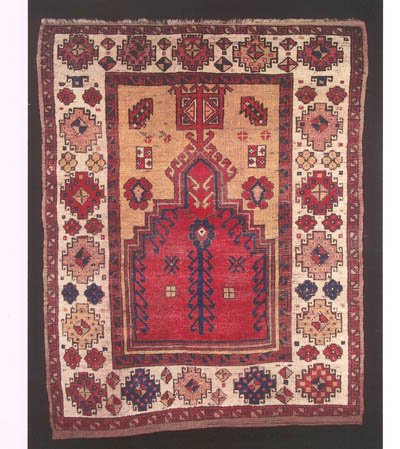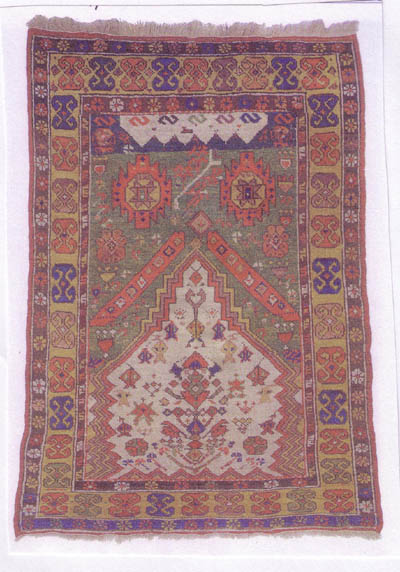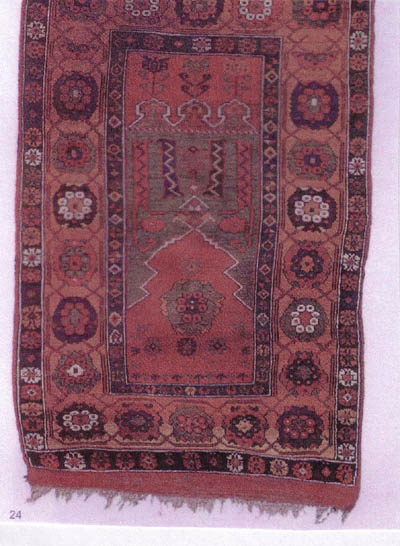Posted by Steve Price on 06-19-2004 04:47 PM:
Konya Prayer Rug
Hi People,
This Konya prayer rug appears on the second page of the
Salon.

It is
an interesting example of a rug with an arch in the field, generally interpreted
as a mihrab, but which cannot possibly be one.
Why not? Funny you
should ask. The usual understanding of the prayer rug used as a clean place to
pray in the five daily prayers required of Muslims is that the person uses it
while kneeling, his feet on the rug near the bottom, his hands in the upper
spandrels and his head touching the interior of the mihrab at times. It
would take a contortionist to accomplish that with this rug. The arch is simply
too far down in the field.
It does, of course, meet two of the three
definitions of "prayer rug": it is of the size known in the trade as prayer
size, and it does have a clearly articulated arch in the
field.
Regards,
Steve Price
Posted by Richard Tomlinson on 06-20-2004 03:46 AM:
Hi
Do small children use prayer rugs?
Just a
thought.
Regards
Richard Tomlinson
Posted by Steve Price on 06-20-2004 06:14 AM:
Hi Richard
I've not seen any small children in mosques during regular
prayer sessions, so I think the answer to your question is "no", although there
are probably exceptions.
But small adults use prayer rugs. What's wrong
with this one is not that it couldn't be used for prayer - a towel or a
newspaper suffices as a clean surface, which is all that's required. But this
one can't be used with the hands on the spandrels, feet off the floor and on the
rug, and head touching the mihrab when it is bowed from the kneeling position.
Not even by someone small.
Regards
Steve Price
Posted by Marvin Amstey on 06-21-2004 08:03 AM:
Wouldn't it be easier to avoid calling it a "prayer rug" and simply describe
it as a decorative rug with a picture of a niche or a view out a window or
whatever strikes your fancy?
Posted by Steve Price on 06-21-2004 09:57 AM:
Hi Marvin
I wish the term "prayer rug" wasn't used for every rug with
an arch form in the field, too. It conjures up romantic fantasies in too many
novice collectors (and some very experienced ones) and leads them to believe
that the rug is something that it isn't. I doubt that it's going to change,
though, and the next best thing is to try to educate people about
reality.
Regards
Steve Price
Posted by Ralph_Kaffel on 06-22-2004 06:47 PM:
Dear Steve,
I must respectfully disagree with your criteria for
defining prayer
rugs. If the proportionate relationship of the size of the
mihrab to a rug's entire area was the standard for judging what is or is not a
prayer rug, then many famous, old prayer rugs would be disqualified. I could
provide many images of all types of prayer rugs in which the mihrab is as far,
or further down the field than in ours, but I will confine myself to three Konya
examples.

The first attachment is a well-known rug, published in Shuhler,
Konig, Volkmann's "Old Eastern Carpets", plate 40, in Bruggemann & Bohmer's
"Rugs of the Peasants and Farmers of Anatolia" and Rippon Boswell, 11 November
1995, lot #44.

The second image is of a 17/early 18th century Konya prayer
rug, from a small museum attached to the Great Mosque of Aksaray, published in
Hali 39, page 30.

The third image is of rug new to the market, offered by Sotheby
London April 30, 2003, lot #24.
You will note that in all three the
mihrab is further down the field than in our rug. Other Central Anatolian
examples you could check out include plate 140 in Ertug and Kocabiyik's
"Anatolian Carpets" and Hali 110, p.86, an ad for Rascid Rahaim in
Venice.
Even if one were to use your criteria, in our rug the mihrab is
topped by a bissected rectangle, a probable representation of the Ka'aba, which
is what the head of the person praying would touch, and he would not have to be
a contortionist to accomplish that. In any event, the mihrab is primarily a
directional device, intended to orient the faithful towards Mecca. It was never
intended as a literal containment area for the
supplicants.
Regards,
Ralph
Posted by Steve Price on 06-22-2004 08:45 PM:
Hi Ralph
The definitions I cited are not my inventions. There are
three, not mutually exclusive. My focus is upon the fact that many people
believe that all rugs with an arch in the field were made for and used in Muslim
prayer. I think this is an error that promotes an overly romanticized notion of
the significance of the arch and, as a consequence, of the significance of the
rug itself.
My first post was worded more carefully than my second one.
It says, The usual understanding of the prayer rug used as a clean place to
pray in the five daily prayers required of Muslims is that the person uses it
while kneeling, his feet on the rug near the bottom, his hands in the upper
spandrels and his head touching the interior of the mihrab at
times.
In my second post I said, What's wrong with this one is not
that it couldn't be used for prayer..., which is obviously not correct. I
went on to say in the same paragraph, ... a towel or a newspaper suffices as
a clean surface, which is all that's required. But this one can't be used with
the hands on the spandrels, feet off the floor and on the rug, and head touching
the mihrab when it is bowed from the kneeling position. Not even by someone
small.
The same considerations apply to the rugs in your last post,
of course. They are certainly prayer rugs by the marketplace definition based on
size. They are certainly prayer rugs based on the definition that anything with
an arch in the design is one. They may even have been used for prayer, although
that is not likely to be knowable unless they came from mosques. They could not
have been used for prayer in the way many people believe prayer rugs are used
(which is the only way I've seen prayer rugs used in mosques, by the way):
...while kneeling, his feet on the rug near the bottom, his hands in the
upper spandrels and his head touching the interior of the mihrab at
times.
Regards
Steve Price
Posted by Steve Price on 06-23-2004 08:20 AM:
Hi Ralph
Just had an afterthought to add: What about "double niche
prayer rugs", with arches at both ends?
Regards
Steve Price



